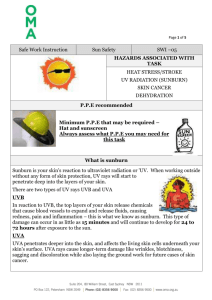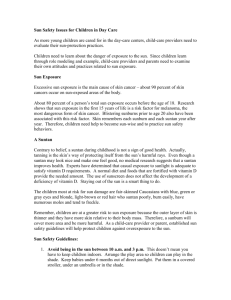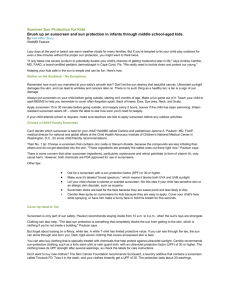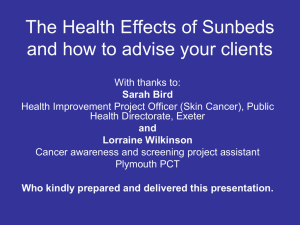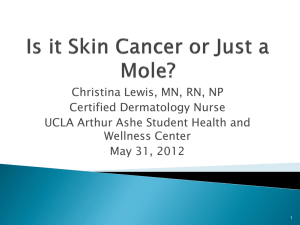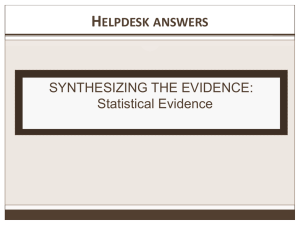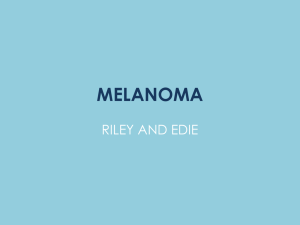Skin Cancer and the NJ Choose Your Cover Program
advertisement
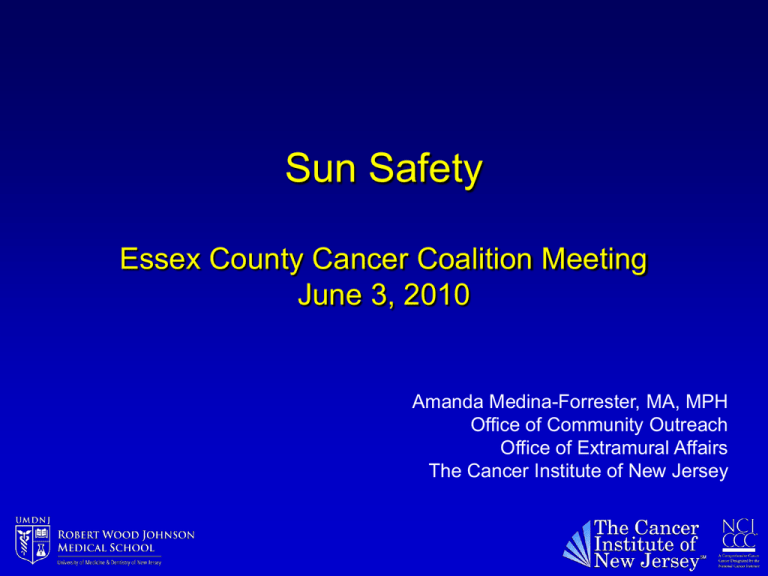
Sun Safety Essex County Cancer Coalition Meeting June 3, 2010 Amanda Medina-Forrester, MA, MPH Office of Community Outreach Office of Extramural Affairs The Cancer Institute of New Jersey What is Choose Your Cover? Going Outdoors in NJ to Fight Melanoma/Skin Cancer • A statewide collaborative initiative • Promotes risk education, early detection and skin cancer screenings at outdoor venues; • Increases awareness about the need for protection from UV rays which is the easiest way to eliminate the most common risk factor for melanoma. Is Skin Cancer THAT Harmful? • • • • • Skin cancer is the most common cancer in the US A history of excessive sun exposure, including sunburns, is a risk factor for melanoma/skin cancer Melanoma is an epidemic and in the United States; since 1995 incidence rates are rising 3.8% per year in those aged 15 to 34 years and 8.85% in those 65 and older since 2003. In NJ Melanoma is a serious threat where the number of new melanoma cases is the fifth in the nation. Melanoma is the 5th most common cancer in men and 6th most common in women. 2008/2009 1,917 NJ beach-goers were screened for skin cancer 555 (29%)referrals including: • 78 (4%) basal cell carcinomas • 36 (2%) squamous cell carcinomas • 62 (3%) suspected melanomas 2008/2009 (cont’d) Thousands of sunscreen samples & skin cancer educational brochures distributed Choose Your Cover 2010 July 17, 2010 (Raindate: July 18) • Goals Simultaneously provide free skin cancer screenings and education at outdoor recreational areas statewide 10 AM to 2 PM – Increase # of: • Participating counties from 4 to 21 • Screening sites from 11 to 28 • Participants from 1,976 to 2,600 – Educate people about skin cancer (# to be determined) CINJ-DEVELOPED MATERIALS Everyone, Regardless of Skin Color, Can Get Skin Cancer [YOUR NAME HERE] [AFFILIATION] By the End of the Session, You Will Know: 1) 2) 3) 4) 5) 6) 7) Am I at risk for skin cancer? Why is my skin so important? What is skin cancer? What makes the sun so dangerous? How do I protect myself from the sun? What is sunscreen? How do I check for skin cancer? Is it OK to Get a Tan or Sunburn? Everyone, regardless of skin color, can sunburn! A suntan or sunburn are not indicators of good health. Tanning and sunburns are just like smoking cigarettes; just one suntan or sunburn can increase your risk of cancer, regardless of skin color. How Do I Protect My Skin? “Slip, Slop, Slap, & Wrap” SLIP on a shirt SLOP on sunscreen and lip balm with an SPF of 15 or higher SLAP on a hat with a 2 to 3-inch brim all around to protect neck, ears, nose and scalp WRAP on sunglasses to protect the eyes and skin around them Any Special Info for Children? • Infant skin burns more easily than that of older kids. • Sunscreen should not be applied to babies under 6 months of age, so just keep them out of the sun whenever possible. – If your infant must be in the sun, dress him or her in clothing that covers the body, including hats with wide brims to shadow the face. – Use an umbrella to create shade. • For kids age 6 months and older, select an SPF of 15 or higher to prevent both sunburn and tanning. How Do I Use Sunscreen? • Apply sunscreen whenever you will be in the sun. • Apply sunscreen about 30 minutes before you go outside so that a good layer of protection can form. Don't forget about lips, hands, ears, feet, shoulders, and behind the neck. • Don't try to stretch out a bottle of sunscreen; apply it generously. • Reapply sunscreen often, approximately every 2 to 3 hours. • Reapply after if you’ve been sweating or swimming. • Apply a waterproof sunscreen if you will be around water or swimming. And regardless of the waterproof label, be sure to reapply sunscreen when you come out of the water. • Throw away any sunscreen products that are past their expiration dates BE SURE TO FOLLOW THESE RULES WITH YOUR KIDS AND LOVED ONES!!! What Should I Look For? – The ABCDE Rule – Asymmetry: One half of the mole does not match the other half. Border irregularity: The edges of the mole are irregular or not smooth. They may look ragged, blurred, or notched. Bob Marley (1945-1981) Reggae musician Died of melanoma which started in his toe and spread to brain *Info provided by Tiffany Weirbach Melanoma Foundation Powerpoints and Pre/Post-Tests available in Spanish and English This is great! How can I get a copy of this to use in my community? CINJ Educational Materials Archive Archive • CINJ materials are available at no cost and available immediately for download • Materials development and design • Materials dissemination • Increase community awareness of cancer prevention, early detection, and treatment Go to http://cinj.org/outreach/ and click on the link in the NEW! section OR https://cinjweb.umdnj.edu/network/outreach/ Thank You! Deb Levinson State Coordinator, Choose Your Cover Mountainside Hospital Statewide Melanoma Workgroup, NJ Office of Cancer Control and Prevention, & CINJ Faculty Robert Wood Johnson Foundation Contact Information Kiameesha Evans, MPH, CHES Program Director evanskr@umdnj.edu Amanda Medina, MA, MPH Program Development Specialist medinaay@umdnj.edu Ciara Rivera Staff Assistant riveraci@umdnj.edu Office of Community Outreach The Cancer Institute of New Jersey www.facebook.com/TheCINJ
